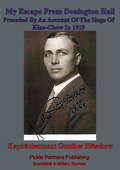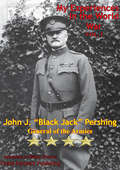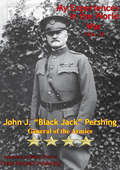- Table View
- List View
My Double Life: Sexty Yeers of Farquharson Around with Don Harn
by Don HarronThe colourful story of Don Harron’s 77-year career in the entertainment business. After 15 books about somebody else (mostly alter ego Charlie Farquharson) plus one book by his drag-queen character, Charlie’s rich city cousin Valerie Rosedale, Don Harron now presents the story of his 77-year stint in the entertainment business. The actor’s colourful career includes such highlights as making money in 1935 as a 10-year-old cartoonist doing mother-and-son banquets; winning an ACTRA Award as best radio host for Morningside; six stage shows on Broadway, three in London’s West End, and 10 years of Shakespeare in three countries; a Gemini Award for lifetime achievement; writing the lyrics for five musicals, including Anne of Green Gables; and being appointed to the Canadian Country Music Hall of Honours due to his appearances on Hee Haw. Whether playing a serious stage role or hamming it up as Charlie Farquharson, Harron is always insightful and provides a unique perspective on a long life in the entertainment business.
My Dream Time: A Memoir of Tennis & Teamwork
by Ashleigh BartyIt’s a tennis story. It’s a family story. It’s a teamwork story. It’s the story of how I got to where and who I am today.I’m only in my mid-twenties, and some might think that’s young to write a memoir. Who does that, right? But for me and my team it’s always been important to reflect on every part of the journey, especially the end. In that context, the timing is perfect to share my story, from the first time I picked up a racquet as a 5-year-old girl to the night I packed up my tennis bag after winning the 2022 Australian Open. This book gives me a chance to look back at every moment of the 20 years in between, and to think carefully through the highs and lows, the work and the play, the smiles and the tears.My Dream Time is about finding the path to being the best I could be, not just as an athlete but as a person, and to consider the way those identities overlap and compete. We all have a professional and a personal self. How do you conquer nerves and anxiety? How do you deal with defeat, or pain? What drives you to succeed – and what happens when you do? The answers tell me so much, about bitter disappointments and also dreams realized—from injuries and obscurity and self-doubt to winning Wimbledon and ranking number 1 in the world.My story is about the power and joy of doing that thing you love and seeing where it can take you, about the importance of purpose – and perspective—in our lives.
My Dream To Be Free
by Juergen Stollin Hannah GunasinghAutobiography. This is the story of a man from German, who had worked as a cook on a ship, spent many years abroad in several countries including Egypt, Sri Lanka, India and who is now living in Tenerife.
My Dream of Martin Luther King
by Faith RinggoldThe author recounts the life of Martin Luther King in the form of her own dream.
My Dream of Stars: From Daughter of Iran to Space Pioneer
by Homer Hickam Anousheh AnsariIn her heartwarming and empowering memoir, space pioneer Anousheh Ansari tells the story of her childhood in Iran and her family's exodus to America after the Islamic Revolution. After settling down in Texas, Anousheh built a computer technology firm from the ground up, which eventually realized a net worth of $750 million and ultimately allowed her to achieve her childhood dream of spaceflight. In her groundbreaking role as the first-ever female commercial spaceflight participant, her story became politicized and fraught with the prejudices and obstacles she had to overcome as an Iranian woman, culminating in a debate over whether she would be allowed to display both the American and Iranian flags on the sleeve of her spacesuit. After her return to Earth, Anousheh started The Ansari Foundation, a quickly growing nonprofit which supports social entrepreneurship, and is especially committed to ensuring the freedom of women around the world and supporting female entrepreneurs. Ultimately, this evocative story shows the triumph of a woman who has become a role model to people around the globe struggling to overcome economic and cultural barriers, as well as those dreamers who look upon the stars and wish to soar among them.
My Dyslexia
by Philip SchultzDespite winning the Pulitzer Prize for Poetry in 2008, Philip Schultz could never shake the feeling of being exiled to the "dummy class" in school, where he was largely ignored by his teachers and peers and not expected to succeed. <P><P>Not until many years later, when his oldest son was diagnosed with dyslexia, did Schultz realize that he suffered from the same condition. <P>In his moving memoir, Schultz traces his difficult childhood and his new understanding of his early years. In doing so, he shows how a boy who did not learn to read until he was eleven went on to become a prize-winning poet by sheer force of determination. <P> His balancing act ”life as a member of a family with not one but two dyslexics, countered by his intellectual and creative successes as a writer ”reveals an inspiring story of the strengths of the human mind.
My Dyslexia
by Philip Schultz"A success story . . . proof that one can rise above the disease and defy its so-called limitations on the brain."--Daily Beast Despite winning the Pulitzer Prize for Poetry in 2008, Philip Schultz could never shake the feeling of being exiled to the "dummy class" in school, where he was largely ignored by his teachers and peers and not expected to succeed. Not until many years later, when his oldest son was diagnosed with dyslexia, did Schultz realize that he suffered from the same condition. In his moving memoir, Schultz traces his difficult childhood and his new understanding of his early years. In doing so, he shows how a boy who did not learn to read until he was eleven went on to become a prize-winning poet by sheer force of determination. His balancing act--life as a member of a family with not one but two dyslexics, countered by his intellectual and creative successes as a writer--reveals an inspiring story of the strengths of the human mind.
My Ear at His Heart: Reading My Father
by Hanif KureishiDescribed in a recent New York Times Magazine profile as a "postcolonial Philip Roth," Hanif Kureishi first captured the attention of audiences and critics in the 1980s with the award-winning novel The Buddha of Suburbia and the films My Beautiful Laundrette, and Sammy and Rosie Get Laid. In three decades of acclaimed work, Kureishi has written fiction and films exploring a series of interconnected themes about identity and desire-—from Islamic radicalism to kinky sex, and from psychoanalysis to the relationships of fathers and sons. After discovering an abandoned manuscript of his father’s, hidden for years, Kureishi was compelled to turn his "unflinching perspective" (Time Out) onto his own history. Like Roth, Martin Amis and Geoffrey Wolfe, who also have written books about their fathers, Kureishi wanted to understand and perhaps to reconcile. My Ear at His Heart offers remarkable insight into the birth of a writer, chronicling how Kureishi’s own literary calling emerged from the ashes of his father’s aspirations. And so begins a journey that takes Kureishi through his father’s privileged childhood by the sea in Bombay, through the turbulent birth of Pakistan and to his modest adult life in England—-his days spent as a civil servant, his nights writing prose, hopeful of one day receiving literary recognition. "A beguiling and complex tale of fact, fiction and family tensions" (The Guardian), My Ear at His Heart was published to great acclaim in the United Kingdom in 2004 and went on to win the prestigious Prix France Culture Etranger.
My Early Life
by Winston Churchill William ManchesterHere, in his own words, are the fascinating first thirty years in the life of one of the most provocative and compelling leaders of the twentieth centuryWinston ChurchillAs a visionary, statesman, and historian, and the most eloquent spokesman against Nazi Germany, Winston Churchill was one of the greatest figures of the twentieth century. In this autobiography, Churchill recalls his childhood, his schooling, his years as a war correspondent in South Africa during the Boer War, and his first forays into politics as a member of Parliament. My Early Life not only gives readers insights into the shaping of a great leader but, as Churchill himself wrote, "a picture of a vanished age."If you want to fully understand Winston Churchill, My Early Life is essential reading.
My Early Life
by Winston ChurchillHere, in his own words, are the fascinating first thirty years in the life of one of the most provocative and compelling leaders of the twentieth century Winston Churchill As a visionary, statesman, and historian, and the most eloquent spokesman against Nazi Germany, Winston Churchill was one of the greatest figures of the twentieth century. In this autobiography, Churchill recalls his childhood, his schooling, his years as a war correspondent in South Africa during the Boer War, and his first forays into politics as a member of Parliament. My Early Life not only gives readers insights into the shaping of a great leader but, as Churchill himself wrote, "a picture of a vanished age." If you want to fully understand Winston Churchill, My Early Life is essential reading.
My Early Years
by Fidel CastroExcerpting conversations between Cuban President Fidel Castro and Brazilian priest Frei Bretto, this work contains Castro's own account of his childhood and youth. It also contains a 1995 speech by Castro at the U. of Havana in which he reflects on his days as student organizer and Colombian journalist Arturo Alape about the April 1948 popular uprising in Colombia, which Castro witnessed. New to this edition are excerpts from Castro's prison letters shortly after the failed attack on the Moncada barracks in 1953. Annotation ©2006 Book News, Inc., Portland, OR (booknews.com)
My Effin' Life
by Geddy LeeThe long-awaited memoir, generously illustrated with never-before-seen photos, from the iconic Rock and Roll Hall of Famer, Rush bassist, and New York Times bestselling author of Geddy Lee's Big Beautiful Book of Bass.Geddy Lee is one of rock and roll's most respected bassists. For nearly five decades, his playing and work as co-writer, vocalist and keyboardist has been an essential part of the success story of Canadian progressive rock trio Rush. Here for the first time is his account of life inside and outside the band.Long before Rush accumulated more consecutive gold and platinum records than any rock band after the Beatles and the Rolling Stones, before the seven Grammy nominations or the countless electrifying live performances across the globe, Geddy Lee was Gershon Eliezer Weinrib, after his grandfather was murdered in the Holocaust.As he recounts the transformation, Lee looks back on his family, in particular his loving parents and their horrific experiences as teenagers during World War II.He talks candidly about his childhood and the pursuit of music that led him to drop out of high school.He tracks the history of Rush which, after early struggles, exploded into one of the most beloved bands of all time.He shares intimate stories of his lifelong friendships with bandmates Alex Lifeson and Neil Peart—deeply mourning Peart’s recent passing—and reveals his obsessions in music and beyond.This rich brew of honesty, humor, and loss makes for a uniquely poignant memoir.
My Egypt Archive
by Alan MikhailA prominent historian provides an engaging on-the-ground account of the everyday authoritarianism that produced the Arab Spring in Egypt “A visceral and perceptive study of life under autocracy.”—Publishers Weekly An unmatched contemporary history of authoritarian politics and an unflinching examination of the politics of historical authority, My Egypt Archive is at once a chronicle of Egypt in the 2000s and a historian’s bildungsroman. As Alan Mikhail dutifully collected the paper scraps of the past, he witnessed how the everyday oppressions of a government institution led most Egyptians to want to remake their society in early 2011. In telling these stories of the archive, Mikhail centers the politics of access, interpersonal relationships, state power, and the emotion, anxiety, and inchoate nature of historical research. My Egypt Archive reveals the workings of an authoritarian regime from inside its institutions in the decade leading up to the Arab Spring and, in doing so, points the way to exciting new modes of historical inquiry that give voice to the visceral realities all historians experience.
My England Years
by Bobby CharltonSir Bobby Charlton is widely acknowledged as the greatest player ever to wear an England shirt. He won a record number of caps and scored a record number of goals. Here, in the second volume of his bestselling autobiography, Sir Bobby talks in detail about his phenomenal career with England. During the 12 years he played for his country, he was involved in some of the greatest England games of all time: the 9-3 thrashing of Scotland, the 1962 and 1970 World Cup games against the Brazilians, the classic 1970 World Cup quarter-final against West Germany and, of course, the triumph of the 1966 World Cup. His story encompasses drama, passion, goals, controversies, classic matches, world-class players, and moments of footballing genius. A truly inspirational story from a true football legend.
My England Years
by Bobby CharltonSir Bobby Charlton is widely acknowledged as the greatest player ever to wear an England shirt. He won a record number of caps and scored a record number of goals. Here, in the second volume of his bestselling autobiography, Sir Bobby talks in detail about his phenomenal career with England. During the 12 years he played for his country, he was involved in some of the greatest England games of all time: the 9-3 thrashing of Scotland, the 1962 and 1970 World Cup games against the Brazilians, the classic 1970 World Cup quarter-final against West Germany and, of course, the triumph of the 1966 World Cup. His story encompasses drama, passion, goals, controversies, classic matches, world-class players, and moments of footballing genius. A truly inspirational story from a true football legend.
My Escape From Donington Hall, Preceded By An Account Of The Siege Of Kiao-Chow In 1915
by Kapitänleutnant Gunther Plüschow"An outstanding story of the aerial war and a daring escape from captivity.For the uninitiated this book's original title, 'My Escape from Donnington Hall,' gave few clues as to the astonishing and unique nature of its contents. Its author was a young German, Gunther Plüschow. As an airman in German service at the outbreak of the First World War he was, unusually, serving in China flying a Rumpler-Taube aircraft from the East Asia naval station at Tsingtau that became besieged by joint Japanese and British forces. Plüschow's attempt to fly to safety, as it became obvious the position would fall, ended in a crash in rice paddies. He set out to walk back to Germany and the many adventures that followed would alone would qualify his story as a remarkable one. However, he was eventually captured and became a prisoner of war. Stories of wartime escape abound, but those who have been incarcerated in England have always been confounded by the difficulties of quitting an island.' In Plüschow's case this was exacerbated since in the east he had acquired a distinctive dragon tattoo; yet Plüschow he succeeded and is the only prisoner of war to escape from Britain and make the 'home run.' His remarkable narrative of his wartime adventures makes absolutely essential reading and is certainly beyond compare."-Leonaur Print version.Author -- Kapitänleutnant Gunther Plüschow 1886-1931.Translator -- Pauline De Chary. D. 1943Text taken, whole and complete, from the edition published in London, John Lane, 1922.Original Page Count - vii and 243 pages.Illustrations -- 2 Illustrations.
My Escape from Donington Hall: Preceded By An Account Of The Siege Of Kiao-chow In 1915
by Gunther PlüschowIt was an escape from a PoW camp as daring and fraught with danger as any immortalised by Hollywood. Yet the story is less familiar than most as it concerns the only German prisoner of war to escape from captivity in mainland Britain and make it home during either World War.After being caught in Gibraltar during an earlier attempt to return to his homeland, Pluschow and other captured Germans were shipped to Plymouth and then on to the PoW camp at Donington Hall, where he arrived in May 1915.On July 4 he and fellow prisoner Oskar Trefftz broke out by climbing over two 9ft barbed wire fences, before changing clothes and walking 15 miles to Derby where they caught a train to London.By the next morning the men's escape was featured in the Daily Sketch newspaper with both names and descriptions of the pair. They went their separate ways but Trefftz was recaptured at Millwall Docks. Realising he had to alter his appearance, Pluschow removed his smart tie and handed his coat in at the cloakroom at Blackfriars station. The German then used scraped-up coal dust, boot polish and Vaseline to change his fair hair to greasy black and covered himself in soot to make him appear as a dock worker. Pluschow then stowed away on a Dutch steamer ship at Tilbury docks, talked his way past a policeman in Holland before travelling to Germany by train. Upon his return home he received a hero's welcome and was presented with the Iron Cross First Class.This extraordinary story is told in Gunther's own words for the first time in English.
My Escape: An Autobiography
by Benoite GroultThis witty autobiography captures the rich and varied life of a renowned French author and pioneering feminist, through the obstacles and movements in twentieth-century France. Born in 1920 in Paris, Benoite Groult obtained the right to vote only when she was twenty-five years old. She married four times, bore three children, underwent several illegal abortions, became a writer after she turned forty, and a feminist in her fifties. Groult chronicles her experiences and her intellectual developments through successive phases--as an obedient child, an awkward and bookish adolescent, and a submissive wife--until finally becoming a liberated novelist. Here, she recounts the childhood trips she spent with her family, Paris during the occupation, her marriages, motherhood, and her continuous fight for women's rights. At ninety-one years old, she concludes that she has been, and still is, a happy woman--lucky to have captured her freedoms, one by one, paying for them, delighting in them, and loving them. Sexy, chatty, and full of shrewd insight, My Escape covers her years of struggle and success--as a daughter, lover, writer, wife, mother, and reluctant socialite--and draws a portrait of the role of French women in the twentieth century.
My Everything: The Parent I Want to Be, The Children I Hope to Raise
by Einat NathanThe compassionate #1 bestseller in Israel that shows parents—particularly mothers—how to teach children to be strong and independent by seeing the world through their children's eyes and feel it through their children's hearts.Einat Nathan is the mother of five children and a parenting expert and counselor with her own clinic. She first published her book (Haimsheli, by top publisher Kinneret Zmora Bitan) in 2018, and it became the national bestseller of the year across all categories in Israel, making her a national celebrity.My Everything resonated because mothers read it, cried and smiled, and discovered a way to look at their children as independent people, not solely as an extension of who they are or as a calling card. Now translated into English, My Everything is a beautiful and comforting read that reminds mothers how to be patient with their children, to try to remain calm in an age of constant fearmongering, and to appreciate and accept each child as an individual, with their own quirks, gifts, and flaws.Einat writes, "Parenthood is like a bungee jump. It's scary and fun, it makes you fly and often lets you down." This book isn't so much a parenting guide as an exploration of the complex emotional journey of being a parent, reminding us of the courage and energy it requires as well as acknowledging that no parent is perfect and at the end of the day, this relationship is about connection.My Everything is a compassionate, loving answer to The Battle Hymn of the Tiger Mother to teach children to be strong and independent. Part Conscious Parenting and part The Blessings of a Skinned Knee, this is a book that will transform how readers think about raising children, resonating across cultures.
My Experiences In The World War – Vol. I [Illustrated Edition] (My Experiences In the World War #1)
by General of the Armies John Joseph PershingThe Pulitzer prize has been the sought after goal of many thousands of writers ever since it was first awarded in 1917. In 1932, the Pulitzer in the history category was awarded to General John "Black Jack" Pershing for his two volume memoirs spanning his time in command of the American Forces in World War One. Given that Pershing should receive such an illustrious prize in the literary arena outside of his army career was a just testament to his multi-faceted and outstanding talents. As the First World War raged into its fourth year, the lifeblood of the Allied forces on the Western Front laid spilt on the fields of Northern France and Flanders. Their only hope in facing the German onslaught lay in the newly mobilized American forces, who had joined the struggle against the central powers in Germany and Austro-Hungary. It would take a commander of towering strength, firm loyalty, and iron determination to change the small American peacetime army into the millions strong wartime colossus it was to become. Such a man was John "Black Jack" Pershing.AS he took command, Pershing was faced with four almightily difficult challenges to overcome in order to achieve success; the first to turn the raw American Doughboys into an army, trained in the new tactics of the industrial carnage of the Western Front. Secondly, to ship enough men, and supplies across the U-boat infested Atlantic to create such an army. Thirdly, to keep his allies hands off American manpower that became trained and ready for battle, they should fight under American flags and American leaders. It was only once the first three huge challenges were overcome could he think about his fourth, how his new troops could fight and beat the battle-hardened German army: but fight and beat them they did!A Pulitzer Prize winning classic!
My Experiences In The World War – Vol. II [Illustrated Edition] (My Experiences In the World War #2)
by General of the Armies John Joseph PershingThe Pulitzer prize has been the sought after goal of many thousands of writers ever since it was first awarded in 1917. In 1932, the Pulitzer in the history category was awarded to General John "Black Jack" Pershing for his two volume memoirs spanning his time in command of the American Forces in World War One. Given that Pershing should receive such an illustrious prize in the literary arena outside of his army career was a just testament to his multi-faceted and outstanding talents. As the First World War raged into its fourth year, the lifeblood of the Allied forces on the Western Front laid spilt on the fields of Northern France and Flanders. Their only hope in facing the German onslaught lay in the newly mobilized American forces, who had joined the struggle against the central powers in Germany and Austro-Hungary. It would take a commander of towering strength, firm loyalty, and iron determination to change the small American peacetime army into the millions strong wartime colossus it was to become. Such a man was John "Black Jack" Pershing.AS he took command, Pershing was faced with four almightily difficult challenges to overcome in order to achieve success; the first to turn the raw American Doughboys into an army, trained in the new tactics of the industrial carnage of the Western Front. Secondly, to ship enough men, and supplies across the U-boat infested Atlantic to create such an army. Thirdly, to keep his allies hands off American manpower that became trained and ready for battle, they should fight under American flags and American leaders. It was only once the first three huge challenges were overcome could he think about his fourth, how his new troops could fight and beat the battle-hardened German army: but fight and beat them they did!A Pulitzer Prize winning classic!
My Experiments with the Truth
by Mohandas Karamchand GandhiFour or five years ago, at the instance of some of my nearest co-workers, I agreed to write my autobiography. I made the start, but scarcely had I turned over the first sheet when riots broke out in Bombay and the work remained at a standstill. it is not my purpose to attempt a real autobiography. I simply want to tell the story of my numerous experiments with truth, and as my life consists of nothing but those experiments, it is true that the story will take the shape of an autobiography. But I shall not mind, if every page of it speaks only of my experiments. I believe, or at any rate flatter myself with the belief, that a connected account of all these experiments will not be without benefit to the reader.
My Extraordinary Ordinary Life
by Maryanne Vollers Sissy SpacekIn her delightful and moving memoir, Sissy Spacek writes about her idyllic, barefoot childhood in a small East Texas town, with the clarity and wisdom that comes from never losing sight of her roots. Descended from industrious Czech immigrants and threadbare southern gentility, she grew up a tomboy, tagging along with two older brothers and absorbing grace and grit from her remarkable parents, who taught her that she could do anything. She also learned fearlessness in the wake of a family tragedy, the grief propelling her "like rocket fuel" to follow her dreams of becoming a performer.With a keen sense of humor and a big-hearted voice, she describes how she arrived in New York City one star-struck summer as a seventeen-year-old carrying a suitcase and two guitars; and how she built a career that has spanned four decades with films such as Carrie, Coal Miner's Daughter, 3 Women, and The Help. She details working with some of the great directors of our time, including Terrence Malick, Robert Altman, David Lynch, and Brian De Palma-who thought of her as a no-talent set decorator until he cast her as the lead in Carrie. She also reveals why, at the height of her fame, she and her family moved away from Los Angeles to a farm in rural Virginia. Whether she's describing the terrors and joys of raising two talented, independent daughters, taking readers behind the scenes on Oscar night, or meditating on the thrill of watching a pair of otters frolicking in her pond, Sissy Spacek's memoir is poignant and laugh-out-loud funny, plainspoken and utterly honest. My Extraordinary Ordinary Life is about what matters most: the exquisite worth of ordinary things, the simple pleasures of home and family, and the honest job of being right with the world. "If I get hit by a truck tomorrow," she writes, "I want to know I've returned my neighbor's cake pan."
My Eyes Have A Cold Nose
by Hector ChevignyThe author says that when he became blind, he thought it would be a great nuissance, and indeed it was. He maintains that the greatest problem for blind people is society's fixed notions that blind people are utterly helpless and utterly tragic, and he describes how he and other blind people have dealt with this problem. One of the key parts of his rehabilitation was his training at The Seeing Eye. This book is old, but still relevant in many ways.





















